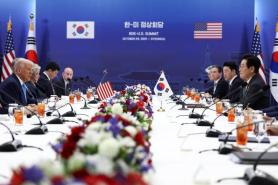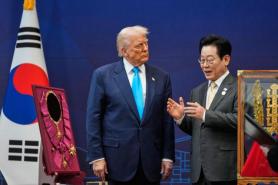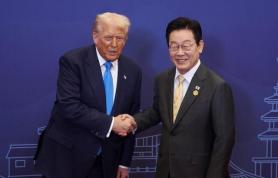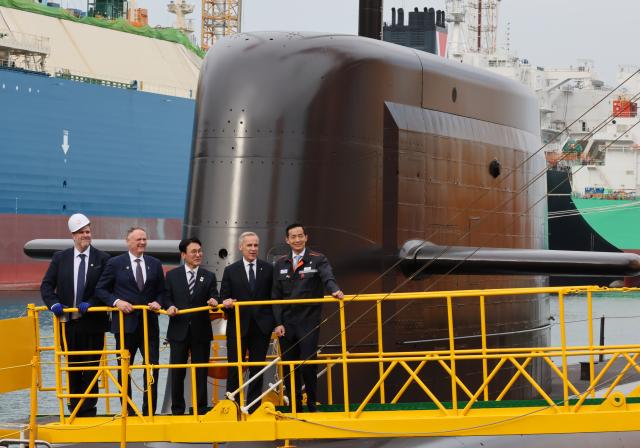
With Washington's unusually explicit approval, President Lee Jae Myung elevated submarine cooperation to the top of his diplomatic agenda, raising the issue in back-to-back summits with Canada and Thailand on the sidelines of the APEC meetings in Gyeongju.
For years, Korea's submarine capabilities have remained overshadowed by its global dominance in commercial shipbuilding. That perception is beginning to shift.
In talks with Canadian Prime Minister Mark Carney, Seoul proposed launching a new Security and Defense Cooperation Partnership to expand joint defense research and industrial collaboration. The discussion comes as Canada prepares a 60 trillion won ($44 billion) next-generation submarine procurement, in which several Korean firms have been shortlisted.
During his meeting with Thai Prime Minister Anutin Charnvirakul, Lee emphasized the need for closer defense and maritime cooperation and encouraged Korean companies to participate in Thailand's defense-modernization projects.
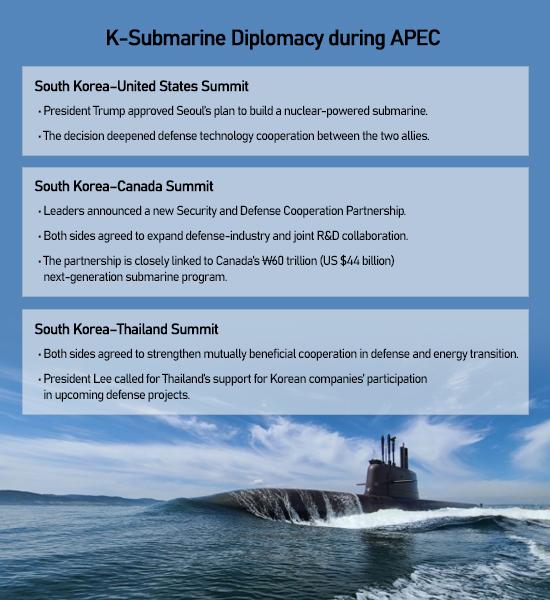
"Submarines are not a sudden diplomatic trend," said Nam Dong-woo, senior advisor at Hanwha Ocean. "Diesel-electric submarine exports have been progressing for years. The current talks simply continue that trajectory."
South Korea now designs and builds its own 3,000-ton KSS-III (Dosan Ahn Changho class) submarines equipped with air-independent propulsion (AIP) systems and lithium-ion batteries, allowing them to remain submerged longer and operate more quietly than traditional diesel models.
Unusually for a non-nuclear state, South Korea has also successfully tested submarine-launched ballistic missiles, giving its fleet a rare form of strategic deterrent capability.
These advances place South Korea among the small group of nations with full-cycle design, manufacturing and export capacity.
"South Korea is one of the few countries capable of building large conventional submarines powered by diesel-electric engines equipped with AIP systems," said Yang Uk, research fellow at the Asan Institute for Policy Studies. He added that Korea's commercial shipbuilding strength has naturally extended into submarine expertise, helping build its reputation as a reliable supplier.
Major builders Hanwha Ocean and Hyundai Heavy Industries anchor the sector, combining proven export experience with cost-efficient, high-performance designs. Their momentum is reflected in the stock market.
Over the past year, Hanwha Ocean shares have surged about 415 percent, from 26,750 won ($19) to around 138,000 won ($100), while Hyundai Heavy Industries has jumped roughly 230 percent, from 182,600 won ($132) to 603,000 won ($437).
The submarine drive is closely tied to Lee's goal of making South Korea the world's fourth-largest defense exporter by 2030.
Submarines, alongside fighter jets and advanced artillery systems, sit at the top of the K-Defense portfolio not only for their technological prestige but also for their long-term economic value. Each contract typically spans decades of maintenance, logistics support and crew training, creating years of sustained partnerships rather than one-off sales.
Nam said the U.S. decision to approve Seoul's pursuit of a nuclear-powered submarine offers major momentum. "Few countries gain such direct access to the U.S. defense market," he said. "Once Washington opens that gate, it validates Seoul’s defense credibility worldwide — from North America to Europe and beyond."
The growing emphasis on submarines also reflects shifting regional dynamics. North Korea claims to have fielded a nuclear-armed submarine, though experts view the capability as limited, and China and Russia have stepped up joint naval operations across the Pacific.
As Seoul's submarine diplomacy accelerates, experts caution that the next test lies in ensuring unified political leadership. Nam noted that defense exports can no longer rely solely on private initiative. "What matters now is how the government takes the lead," he said. "Korea needs a clear control tower to turn defense exports into a coordinated national strategy, and that moment has arrived."
Copyright ⓒ Aju Press All rights reserved.


